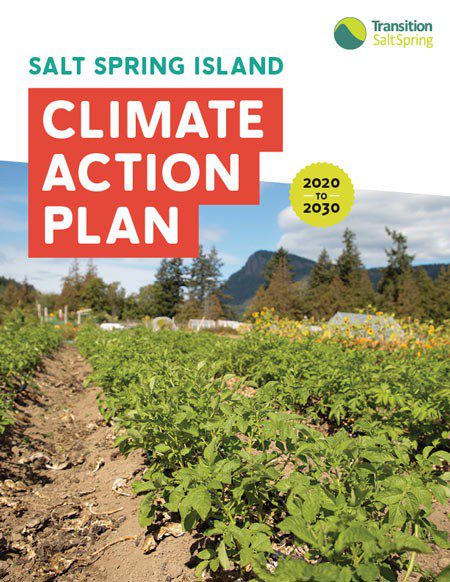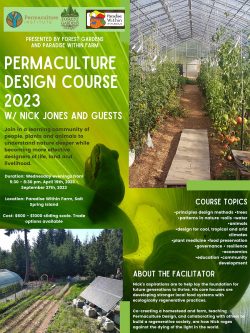Growing & eating local is climate smart.
Food choices made collectively and individually have a large impact on the environment and on climate change. How we grow, process, and distribute food has significant social justice implications globally and locally, with respect to farm workers’ rights and people’s access to healthy food.
The latest IPCC report estimates that 21–37% of total global GHG emissions come from the food system. This includes emissions of all GHGs from land-clearing and agriculture production, as well as the storage, transport, processing, retail, and consumption of food.
Local and regional food systems have advantages over the global industrial model for food security and climate change mitigation and adaptation. The Canadian National Farmers Union recommends that efforts to reduce GHGs in agriculture should focus on three sources that account for 70% of total Canadian agricultural emissions: livestock production (30%), agricultural soils (29%), and fossil fuel use (11%).
Crop and livestock production systems can also draw CO2 out of the atmosphere, storing it permanently in the soil. This positive aspect of food production has been lost under the global industrial model, which depletes soil carbon year after year. Better practices include permaculture methods, use of rotational and ‘bunched’ grazing and permanent pasture, and small-scale intensive management systems that do not fit the global industrial model.
The type of small- and medium-scale agriculture practiced in our region and on Salt Spring in particular fits the regenerative model and presents many opportunities to grow the local and regional food system while reducing our carbon footprint from food.
Home gardens, community gardens, and wild food harvesting should be an integral part of a future low-carbon local food system. Pollution and industrial over-harvesting have destroyed the former bounty of the marine environment that local First Nations stewarded and relied on for millennia. Meanwhile, lack of harvesting of the native deer population has resulted in damage to forest ecosystems and hinders ecosystem restoration.
What Salt Spring Can Do
The overall focus is to support a shift away from reliance on the global industrial food system responsible for the majority of food-related GHG emissions and to instead support the development of Salt Spring’s food and agricultural sector as an important hub in a regionally-based low-carbon food system. A robust local food system that is part of a regional food system increases local food security, reduces GHG emissions, and may provide a number of other environmental and social benefits. Agricultural infrastructure and economic viability for local farmers are prerequisites. The priorities described below are intended to support this shift.
- Build support for a local and regional low carbon food system.
- Increase local food production and resilience to climate change.
- Build knowledge about home gardening, regenerative agricultural practices, and sustainable wild harvesting.
- Reduce food waste by developing an on-island composting facility, and distribute the proceeds to island growers.
- Increase food production, while increasing the sector’s climate change resilience by building grower knowledge about regenerative agriculture to increase soil carbon and enhance crop yields organically.
Resources, News & Events
Future-proof your Home with Water Management: $ave Money and Improve Resiliency by Harnessing Your Water Resources – Video
Welcoming Native Pollinators to Our Neighbourhood Gardens with Bee Expert Bonnie Zand- Video
2023 Permaculture Design Course
Resilient Gardens for a Changing Climate
North American book release for Rosemary Morrow’s new book ‘Earth Restorer’s Guide to Permaculture
Success Stories
Salt Spring Island was one of the first communities in Canada to include GHG emissions from the food sector in its energy and emissions reduction plans. In 2011 over 90% of the food consumed by islanders was grown elsewhere, and CAP 1.0 focused on the promotion of consumer choices — eating less processed food, more organic and vegetarian food, and more local and regional food. Many proposed actions required a significant expansion of local food production capacity, building on the 2008 Salt Spring Island Area Farm Plan, which also focused on expanding local food production. There have since been several important achievements that support climate action. These include:
- Opening of the Salt Spring Abattoir in 2012.
- Construction of The Root local food storage and processing facility which has good potential for the delivery of services outlined in this plan.
- Establishment of a community-based farmland trust that has increased the amount of farm land in food production and long-term tenure for new entrant farmers.
- Expansion of weekly farmers’ markets.
- Establishment of two allotment gardens for home gardeners, a Community Services garden, and food gardens at all local schools.
Salt Spring’s local food and agriculture sector is in some respects a regional leader. CAP 2.0 aims to build on these achievements to lower our island’s GHG emissions and increase resilience to climate change.






